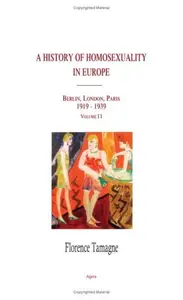
Free Download Florence Tamagne, "A History of Homosexuality in Europe: Berlin, London, Paris 1919-1939, Volume II"
English | 2004 | pages: 356 | ISBN: 0875862780 | PDF | 3,1 mb
Dive into the vibrant tapestry of European cities during a transformative era for LGBTQ+ communities. Florence Tamagne's A History of Homosexuality in Europe: Berlin, London, Paris 1919-1939 unveils the rich, complex narratives of homosexual life in three pivotal cities between the two World Wars. This book reveals how societal attitudes shifted, how cultures collided, and how the quest for identity and love flourished amidst adversity. Uncovering the Cultural Landscape: Tamagne paints a vivid picture of Berlin, London, and Paris during the interwar years-a time of remarkable change. In Berlin, the Weimar Republic fostered an unparalleled atmosphere of freedom and creativity. Nightclubs buzzed with energy as homosexual individuals began to carve out public spaces for themselves. The author explores how this environment inspired a flourishing of art, literature, and intellectual thought, highlighting key figures and movements that emerged during this period. London, in contrast, reveals a more restrained landscape where clandestine gatherings and coded expressions of love thrived beneath the surface of societal repression. Tamagne navigates the duality of public conservatism and private defiance, showcasing the lives of individuals who dared to love openly in secretive societies. Readers will discover how the gay rights movement began to take shape, laying the groundwork for future generations. In Paris, the legendary cultural capital of Europe, the intersection of art and sexuality becomes a rich focal point. The author captures the essence of the city's avant-garde movements and their embrace of sexual diversity. Through the lens of key literary and artistic figures, the book demonstrates how Paris became a sanctuary for those seeking freedom from societal constraints. Challenging Norms and Breaking Barriers: The book delves into the struggles faced by homosexual individuals during a time when laws and societal attitudes were far from accepting. Tamagne confronts the harsh realities of discrimination and persecution, illustrating how fear and stigma forced many into secrecy. However, alongside these challenges, tales of courage emerge. The author brings to life the activism and advocacy that began to take root, igniting a fire of resistance that would resonate in future movements. Personal Stories, Broader Implications: What makes this book compelling is its ability to blend individual stories with larger historical narratives. Tamagne shares personal anecdotes, letters, and interviews that bring to light the lived experiences of those who navigated love and identity in a tumultuous world. These stories serve as poignant reminders of the human spirit's resilience and the power of love in all its forms. Reflecting on a Legacy: As readers journey through the pages of A History of Homosexuality in Europe, they are encouraged to reflect on the progress made and the work that remains. The conversations around sexuality, identity, and acceptance continue to evolve, making this exploration of the past not just a historical account, but a crucial piece of the ongoing dialogue about LGBTQ+ rights today. Conclusion: Florence Tamagne's insightful examination is essential for anyone interested in the history of sexuality and the LGBTQ+ movement. Through rich storytelling and thorough research, she crafts a narrative that not only informs but also inspires. This book is a must-read for those seeking to understand the complexities of love, identity, and societal change during a pivotal moment in European history. Whether you are an academic, activist, or simply curious about LGBTQ+ history, this book offers invaluable perspectives that resonate through time.
Code:
Bitte
Anmelden
oder
Registrieren
um Code Inhalt zu sehen!